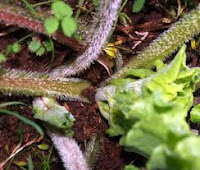The tiger lily is a relative of the much less in your face, lily-of-the-valley, as they are both Liliaceae family members. I think I first encountered a Tiger lily in my great-aunt’s garden in Worcestershire , England Garden of Live Flowers Alice
“'O Tiger-lily,' said Alice
'We can talk,' said the Tiger-lily: 'when there's anybody worth talking to.’"
The tiger lily was much nicer to Alice
There’s no doubt that these flowers are impressive, as they can grow to heights of 4 feet, and the ones in that garden of my childhood were much bigger than me. There is a superstition that if you smell the flowers of the tiger lily you will get freckles, probably because the vibrant orange petals are covered with black spots which resemble freckles.
 Tiger lilies are associated with remedies for uterine problems and it seems that a tincture of the plant is used to strengthen and tone the nerves of that region. It was used in cases of prolapsed uteri. However in traditional Chinese medicine, in which the plant has been used for at least 4,000 years it would seem that it is used for respiratory problems such as bronchitis while the bulb, dried is used in soups as an anti-flu measure. The buds, bulbs and young shoots are all edible, with the roasted bulbs being compared to a baked potato in flavour. They can also be used like kachnar flowers and cooked with meat. Dried parts of this plant are used in egg dishes, so go well in scrambled eggs and omelettes. In
Tiger lilies are associated with remedies for uterine problems and it seems that a tincture of the plant is used to strengthen and tone the nerves of that region. It was used in cases of prolapsed uteri. However in traditional Chinese medicine, in which the plant has been used for at least 4,000 years it would seem that it is used for respiratory problems such as bronchitis while the bulb, dried is used in soups as an anti-flu measure. The buds, bulbs and young shoots are all edible, with the roasted bulbs being compared to a baked potato in flavour. They can also be used like kachnar flowers and cooked with meat. Dried parts of this plant are used in egg dishes, so go well in scrambled eggs and omelettes. In In the Kyoto Japan
The tiger lily is native to China Japan Korea US
There have been several studies carried out by Chinese researchers into the properties of the tiger lily and it has been found to exhibit some anti-tumour activity (Journal of Phytochemistry 1994, September, Vol. 34 (1) 227-32 Mimaki Y. et al “Steroidal Saponins from the bulbs of Lilium lancifolium and their anti-tumour activity”), to be useful in the treatment of mastitis and breast cancer and the bulbs exhibit antibacterial properties as well as being diuretic and antiparasitic.

The roots also have anti-inflammatory properties according to research carried out by Kwon Ok et al, July 26th 2010 , Journal of Ethnopharmacol “Anti-inflammatory effects of methanol extracts of the roots of Lilium lancifolium in LPS-stimulated RAW264.7 cells.”
Research is limited however and more needs to be done to discover if the results of these studies can be reproduced.
It is known that cats and tiger lilies do not get along as the plants can cause renal failure and death to cats. So think twice if you buy Tiger lilies for your garden and have a feline friend.



















































